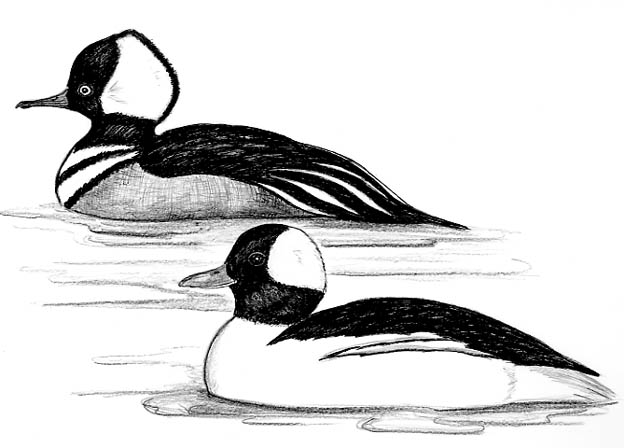
Dear Bird Folks,
A few weeks ago you wrote a wonderful piece about seeing ducks on Cape Cod. Reading your column motivated me to check out my local ponds and much to my surprise your advice was right on the money. However, I’m having a little trouble distinguishing Buffleheads from Hooded Mergansers. Any advice?
– Harry, Sandwich, MA
So close, Harry,
Your question started out so nice and so complimentary that it nearly gave me the warm holiday glow I have been looking for. You referred to my column as “wonderful” and claimed that it motivated you to go birding. It was a perfect way to start my day. But then it all fell apart faster than Tiger Woods’ career. What do you mean you were “surprised” my advice was on the money? My advice is always on the money. My advice is golden. Okay, fine, maybe my report on those invisible Nautilus Ducks (see April, 1st, 2009) was a bit off, but other than that…
I know exactly how you feel. When I first started birding I too had trouble sorting out Buffleheads and Hooded Mergansers. They are both small ducks with disproportionately large heads and white patches on the sides of those jumbo heads. From a distance they look similar, but if you look more carefully you’ll notice the two birds are quite different. The sides of a Bufflehead drake’s body are bright white. The sides of a male Hooded Merganser’s body are coffee-brown, looking like it just returned from a week at Club Med. The females of both ducks have dusky bodies, but the female bufflehead has a rounded head, while the elongated head of the hen hoodie has a swept-back look, as if she had blow-dried her hair with a jet engine.
Buffleheads are easily my favorite duck, but even I have to admit Hooded Mergansers are the more handsome of the two. Take a good look at hoodies in your bird book. It’s hard to imagine that such stately birds live around here. Their elegant plumage looks way out of place on Cape Cod, where sweatshirts and sneakers are considered formal attire.
As you may have guessed Hooded Mergansers get their name from the males’ fancy head crests. The half black, half white head-crest on these birds can either be up or down depending on their mood. When it’s down the crest is pinned back on the bird’s head like a dog’s ears when it is caught sleeping on the couch. But if the duck wants to show off, it will raise the beautiful crest like one of those decorative fans Southern women use when they have a case of the vapors.
Many people are familiar with a typical duckbill, like the ones they see on Mallards, but a merganser’s bill is nothing like those flat things. Their bill is slim and rounded, almost needle-nosed with teeth. Yes, teeth. Well, as close to teeth as any bird is ever going to have. A merganser’s bill is deeply serrated, giving it a saw-like appearance. Why does a bird need faux teeth? A novice might think the serrated bill helps the birds grip their prey better, but the real reason is…no wait, that is the real reason. Mergansers feed by diving underwater and chasing down slippery fish. Once a fish is caught in a merganser’s serrated bill, there is no getting away and dinner is served.
Hooded Mergansers may be well designed for catching fish, but they totally lack nest building skills. Mergansers don’t construct those little fluffy straw nests like many other ducks do. They lay their eggs high off the ground in natural tree cavities. Laying eggs inside a tree trunk is a good way to avoid predators. However, there is a downside to high-rise living. Hatching high above the ground is hard on the flightless ducklings. Only twenty-four hours after crawling out of their eggs, merganser chicks leave the safety of their tree cavity and dive into midair. Falling as much as eighty feet straight down, the baby birds take this huge leap of faith in the hope of landing on something soft. The chicks that survive the fall (and they all usually do) discover their mother waiting for them on the ground. Mom, without so much as a congratulation, a hug or even a high-five, turns away from her chicks, heads to the nearest pond and expects them to follow. Talk about tough love.
In recent years Hooded Mergansers have benefited from our obsession with Wood Ducks. Hoodies will readily use manmade boxes put out for woodies. Yesterday a lady came up to me at the local photo store (usually I don’t speak to people in public, but I was trapped). She told me about a female hoodie that checked out her Wood Duck box in South Orleans. Right now we only see Hooded Mergansers around here during the colder months, but maybe someday soon they’ll be nesting here on Cape Cod. That would be cool.
Historically, Harry, the spunky and abundant Buffleheads have been much easier to see than the less common and introverted Hooded Mergansers. However, the hoodie’s population has been increasing locally and now they too are fairly easy to find. Both are handsome birds and fun to watch. They may not be as handsome or as fun to watch as invisible Nautilus Ducks, but what is?